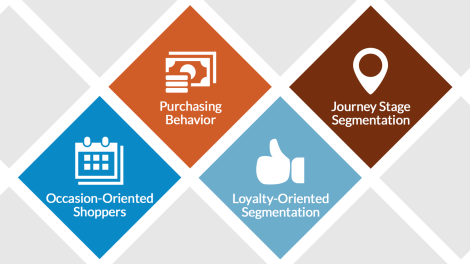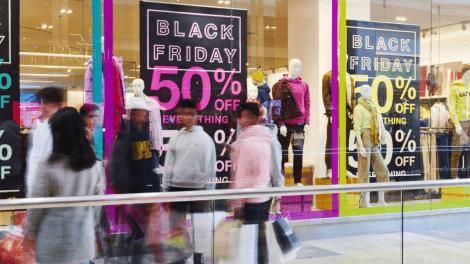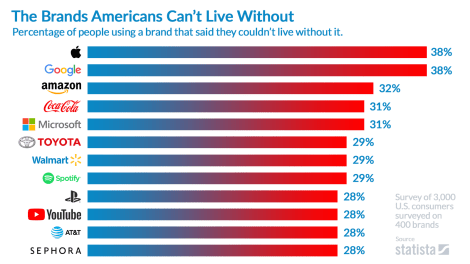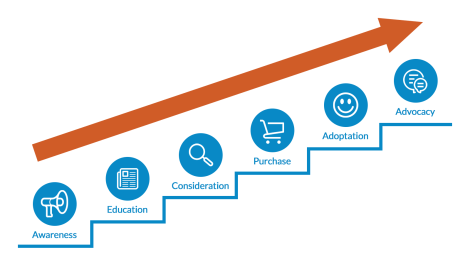It’s happened to everyone who has a Facebook account: you’re scrolling through your feed when suddenly, an advertisement for the exact toaster you were looking at last night on Amazon pops up. Unbeknownst to you, this is behavioral segmentation at work.

What is behavioral segmentation?
Because you don’t know this yet, you post about how creepy it is that Facebook can see inside your mind and actions. In the comments, some people agree with you. Others say it’s simply a marketing tactic and that all major companies do it to help show you relevant advertisements. One smart marketing friend jumps out with the exact term — behavioral segmentation. They let you know that all good marketers are using it to help keep their customers’ buying experiences relevant.
The truth is that, thankfully, Facebook can’t see inside your mind. But it can —and does — use data from cookies and IPs to track everyone’s online behavior. And like every other smart company in the world, Facebook uses behavioral segmentation. Put simply, b
What is behavioral segmentation in marketing?
Here’s what behavioral segmentation looks like in everyday marketing. First, understand that the point of this user segmentation model is to help you understand and anticipate your customers’ desires and needs.
To that end, you need to study your customers’:
- attitude toward your product, service, or brand in general
- use of your product or service and response to that service
- overall knowledge of your brand and products
- purchasing tendencies
How do you identify customer segments?
There are several different characteristics to look out for and study when you’re diving into behavioral segmentation (see below). By knowing these behavioristic variables, you can then use analytics software like Google Analytics, Qualtrics, and Sailthru to find out which of your customers fit into which user segment.
You can also use polling software like PickFu to ask potential audience members directly how they would respond to certain aspects of your product.
The 4 types of Behavioral characteristics in marketing
Let’s take a look at some examples of the main four types of behavioral market segmentation.
Occasion-oriented shoppers
Also known as occasion segmentation, this type of buyer segmentation can be easier to study than others. Occasion-oriented shoppers tend to buy most heavily during holidays and other special occasions.

Let’s pretend we’re the company Pusheen. We sell products based on the popular cat character Pusheen and her friends. We notice that keychain sales tend to go up around Christmastime, so we study our customers to find out who purchases more keychains as Christmas gifts. Then, we put those buyers into a segment together and send them marketing emails in the days leading up to Christmas and other holidays that they’re likely to buy gifts for: Mother’s Day, for example, and even lesser-known but equally celebration-worthy holidays like National Best Friends Day. Add a sale or promo to that marketing email and your chance at securing a conversion goes up.
Your seasonal buyers can be a fantastic source of revenue if you know how to market to them.
Purchasing behavior
Within your audience, there exist all types of buyers: the bargain-hunting shoppers who only buy things that are on sale or clearance. The spontaneous shoppers who purchase everything they see. The careful buyers who research products across several different sites, read

Think about the shopper who leaves items in the cart for a long time but does eventually come back to purchase. The buyer who won’t purchase unless free shipping is offered (and who might just spend that minimum $30 to get free shipping). The buyer who needs an easy returns policy in order to commit.
Many times, these behavior types blend and blur. Disentangle them as much as you can and split them into segments!
Benefit-seeking buyers
When you go to the hair care section of your local Target, what do you look for in a shampoo? There are dozens to choose from. But if you have curly hair, you’ll probably grab a shampoo that speaks specifically to you, the curly-haired person. Example: L’Oréal Paris’s “anti-frizz, non-drying” Ever Curl Shampoo and Conditioner.
If you have super oily hair, on the other hand, you might buy Head And Shoulders Instant Oil Control Dandruff Shampoo.
In short, benefits-based buying is when you purchase a specific shampoo based on its benefits to you. You choose the product based off the benefits that they provide you.
It’s important to take note of which of your customers buy products based on specific benefits. While this is true for any type of product, it’s especially important if you sell products and services that specifically benefit different characteristics. For example:
- personal care products (shampoo, conditioner, body wash, toothpaste)
- beauty products (foundation, mascara, lipstick)
- services that accommodate a range of abilities (writing-coach services, tutoring, courses of any kind)
- massage therapy and spa packages
Loyalty-oriented purchasing
Sometimes you’ll see a post on Instagram that says something like, “I LOVE this coffee from @bestcoffeeshopever, seriously the best I’ve tasted in my life and there isn’t even sugar in it. If you know me you know that is huge!!”

The tag doesn’t mention an advertisement, because it isn’t one. It’s someone who really, truly loves a product so much that they had to post about it on social media — and tag the company.
This is every business owner’s dream. While this hypothetical person will probably get coffee at other coffee shops sometimes, she’ll stick to @bestcoffeeshopever as much as she can because it’s her favorite. She’s a loyal customer.
It is well worth your time to find out who your loyal customers are and group them together. Known as loyalty segmentation, it’s one of the most valuable groups in your audience.
Think about how major companies reward their most loyal customers. Starbucks has a rewards program that enables frequent customers to collect stars, which earn them free drinks and meal items. Which, of course, keeps them coming back to Starbucks.
Alaska Airlines (and most airlines, for that matter) has a program where if you use its credit card, you earn frequent flyer miles — plus you get one “buy one, get one free” flight every year. Because of these two things, pretty much everyone who lives in Alaska is a loyal Alaska Airlines customer. They might even convince out-of-state family members to sign up for the Alaska card.
Happy loyal customers make perfect advocates for all types of brands. Make sure you know who your loyal customers are and create campaigns that reward them for that loyalty. Their satisfaction will keep your business strong.
Usage-oriented customers
In user status segmentation, you look at your sales and often the actions within those sales to figure out how often someone uses your product.
Airbnb
Take Airbnb. The lodging-brokerage site is increasingly popular, and you can bet that the company pays attention to how often its customers make Airbnb bookings. Those customers then receive notifications about upcoming Airbnb offers.
Airbnb goes a step further, offering customers the opportunity to rent out their own home while they themselves are on vacation. Airbnb’s business model has an unusual focus: co-founder Brian Chesky said in a 2016 interview with Fast Company that, “This company is first and foremost about the hosts, not the guests.”
The hosts pay a service fee for each booking they take on their properties. Guests also pay Airbnb a service fee, but it’s the hosts that find the guests. So it makes sense that Airbnb encourages its guest customers to turn into host customers. And the more a guest user books with Airbnb, the more often they are gone from their own home.
Airbnb can keep pitching the potential of making money from hosting while guest users are on vacation, likely seeing new hosts join its platform as a result.
Netflix Behavioral Segmentation
In another example, Netflix saves money and keeps its customers by knowing their usage patterns. According to marketing expert Neil Patel, Netflix likely wants its users to watch a certain amount of hours of Netflix every month.
Using analytics, the company has probably figured out that a certain number of hours watched per month brings with it a higher percentage of user retention, that is, users who don’t cancel their subscription.
This drives Netflix to customize each viewer’s experience to be as relevant and interesting to that user as possible.
Because user behavior and Netflix itself are both always changing, Netflix is constantly tracking usage — time spent on Netflix, amount of pauses, fast-forwards, or re-winds, what time of day customers watch — to personalize their customers’ experience.
This type of user category marketing can benefit you, too.
Journey stage segmentation
In journey stage segmentation, your goal is to find out where customers are in their journey. Group them together and create advertisements targeted to each group.

The customer journey stages are as follows:
- Awareness — customer finds out the product exists
- Education — customer learns about the product
- Consideration — customer thinks about what the product can do for them
- Purchase — customer becomes a first-time buyer or user
- Adoption — customer retains product and/or buys again (or rejects it)
- Advocacy — customer spreads the word about the product
For audience members in the awareness stage, figure out how to get them interested in learning more about you and your services. With audience members in the consideration stage, try to nudge them into becoming first-time buyers. If a shopper leaves an item in their online carts, that customer is in the consideration phase. A smart company will then remind the customer to come back and buy.
Why is behavioral segmentation important?
Behavioral segmentation goes a step deeper than demographic segmentation. While demographic segmentation is an important starting point, it’s important to understand your audience on a deeper level. This knowledge helps you customize your messaging to specific groups of people who are displaying similar behaviors.
Behavioral segmentation is not always cut and dry. Sometimes your customers behave in manners that seem irrational, but even studying strange or back-and-forth behaviors can help you better understand your customers.
In the long run — and often the short run, too — behavioral segmentation saves you money, earns you new customers, and helps you keep current ones.
What behavioral segments can I target on PickFu?
On PickFu, you can target the following behavioral segments:
- Ai Tools Users - Target People who use AI tools for funs, People who use AI tools professionallies, and People who don't use AI tools
- App Store Spending Habits - Target Non-paying app store users, Users who spend $100 on the app stores
- Assistive Tools Users - Target Assistive technology users and People who don't use assistive technologies
- Audio Equipment Preference - Target Standard speaker users, Wireless speaker users, Home audio enthusiasts, Audiophiles, and Standard headphone users
- Audiobook Listener - Target Audiobook listeners and People who don't listen to audiobooks
- Beauty Product Preferences - Target People who prefer natural beauty products, People who prefer affordable beauty products, People who prefer luxury beauty products, and People who prefer new beauty products
- Beer Consumer - Target Beer consumers and People who don't consume beers
- Book Subscription - Target Audible subscribers, Blinkist subscribers, Bookmate subscribers, Kindle Unlimited subscribers, OverDrive users s, Scribd subscribers, Other services subscribers, and Non-subscribers
- Browser Used - Target Chrome users, Edge users, Firefox users, Internet Explorer users, Opera users, Safari users, Samsung Internet users, and Other browsers users
- Car Fuel Type - Target Diesel car owners, Electric car owners, Gas car owners, Hybrid car owners, and People who don't have a vehicles
- Chess Players - Target Offline chess players, Online chess players, and People who don't play chesses
- Clothing Fit Preference - Target
- Coffee Drinker - Target Coffee drinkers and People who don't drink coffees
- Coffee Drinking Frequency - Target Drinkers of <1 cup of coffee a days, Doesn't drink coffees, Drinkers of 1-3 cups of coffee a days, and Drinkers of 3+ cups of coffee a days
- Cosmetics And Body Care Habits - Target Essentials users (up to 4 body care products)s and Enthusiasts (5+ body care products)s
- Crowdfunding Participant - Target People who haven't donated to crowdfunding campaigns and Crowdfunding participants
- Dating Apps Users - Target People who have used dating apps and People who haven't used dating apps
- Dietary Habits - Target Dairy-free diet adherents, Gluten-free diet adherents, Halal food adherents, Keto diet adherents, Low-carb diet adherents, Kosher food adherents, Omnivores (non-vegetarians)s, Vegans, Vegetarians, Low fat diet adherents, and Organic and/or no processed food adherents
- Dressing Style - Target Artsy/artie style fans, Bohemian/boho chic style fans, Business style fans, Casual style fans, Classic style fans, Exotic style fans, Retro/vintage style fans, Rock style fans, Sporty/athleisure style fans, Streetwear style fans, Other style fans, and People unsure about their styles
- Earplug User - Target Earplugs users and People who don't use earplugs
- Exercise Frequency - Target People who exercise less than once a weeks, People who exercise 1-3 times a weeks, and People who exercise 4+ times a weeks
- Favorite Book Genres - Target Apocalyptic/dystopian readers, Arc, archetecture, and photography readers, Biography readers, Business readers, Children's book readers, Christian book readers, Classics readers, Cookbook, food, and wine readers, Diet, health, and fitness readers, Fantasy readers, Fiction readers, Graphic novel and comic readers, History readers, Horror/paranormal readers, Humor/entertainment readers, Mystery and crime readers, Nonfiction readers, Politics and social sciences readers, Religion and spirituality readers, Romance readers, Science fiction readers, Self-help and relationships readers, Sports readers, Teen and young adult book readers, Thriller and suspense readers, and Travel readers
- Favorite Mobile Game Genres - Target Action game fans, Adventure game fans, Arcade game fans, Board game fans, Card game fans, Casino game fans, Educational game fans, Family game fans, Music game fans, Puzzle game fans, Racing game fans, Role playing game fans, Shooter game fans, Simulation game fans, Sports game fans, Strategy game fans, Trivia game fans, and Word game fans
- Favorite Mobile Game Modes - Target Mobile gamers who prefer single players, Mobile gamers who prefer multiplayer with bots, Mobile gamers who prefer multiplayer with friends/families, and Mobile gamers who prefer multiplayer with strangers
- Favorite Movie Genres - Target Action movie fans, Adventure movie fans, Animation movie fans, Comedy movie fans, Crime movie fans, Drama movie fans, Documentary fans, Family movie fans, Fantasy movie fans, History movie fans, Horror movie fans, Mystery movie fans, Romance movie fans, Sci-fi movie fans, Superhero movie fans, and Thriller movie fans
- Favorite Social Media Platforms - Target Discord users, Facebook users, Instagram users, LinkedIn users, Pinterest users, Reddit users, Snapchat users, TikTok users, Tumblr users, Twitch users, Twitter users, WhatsApp users, and YouTube users
- Favorite Sports - Target Athletics fans, Badminton fans, Baseball fans, Basketball fans, Boxing fans, Cricket fans, American football fans, Golf fans, Ice hockey fans, Martial arts fans, MMA fans, Motor sport fans, Soccer (European football) fans, Swimming fans, Table tennis fans, Tennis fans, Volleyball fans, Winter sports fans, X-games fans, Other sports fans, and People who don't watch any sports
- Favorite Stores For Beauty Products - Target Amazon beauty product shoppers, Beauty store beauty product shoppers, Department store beauty product shoppers, and Drugstore/low cost retail store beauty product shoppers
- Favorite Stores For Home Goods - Target Amazon home goods shoppers, Crate and Barrel home goods shoppers, HomeGoods home goods shoppers, Ikea home goods shoppers, Macy's home goods shoppers, Overstock home goods shoppers, Pottery Barn home goods shoppers, Target home goods shoppers, The home depot home goods shoppers, Walmart home goods shoppers, Wayfair home goods shoppers, and Buy home goods somewhere elses
- Frequently Purchased Toys - Target Action figures toys buyers, Animals toys buyers, Cars and radio controlled toys buyers, Construction toys buyers, Creative toys buyers, Dolls buyers, Educational toys buyers, Electronic toys buyers, Food-related toys buyers, Games buyers, Model building toys buyers, Physical activity and dexterity toys buyers, Puzzle/assembly toys buyers, Science and optical toys buyers, Sound toys buyers, Wooden toys buyers, and People who don't buy toys
- Gambling Habits - Target Casino game players, Lottery/scratch card players, Race betting participants, Sports betting participants, Other betting participants, and People who don't gambles
- Gaming Consoles Played - Target Android players, iOS players, Cloud streaming gamers, Epic players, Nintendo Switch players, Oculus VR players, PC gamers, PlayStation 4 Pro players, PlayStation 5 players, Xbox One X players, Xbox Series X/S players, Non-console gamers, and Steams
- Hair Type - Target
- Hobbies And Interests - Target Athletics, Playing video games, Swimmings, Artists/crafters, Boaters, Campers, Boardgamers, Card collectors, Home chefs, Crocheters/knitters, Gardeners, Health and fitness enthusiasts, Hikers, Hunters/fishers, Interior decorators/renovators, Photographers/videographers, Musicians, Readers, RVers/motor caravanners, Technology enthusiasts, Traveling enthusiasts, Museum-goers and gallery-goers s, TV sports fans, and Fans of other hobbies/interests
- Hours Spent Mobile Gaming - Target Gamers who play <1 hour a weeks, Gamers who play 1-3 hours a weeks, Gamers who play 4-6 hours a weeks, and Gamers who play 7+ hours a weeks
- Interest In Cooking - Target People who don’t cooks, People who cook only out of necessities, and Avid home cooks
- Kids Toy Buying Frequency - Target People who never buy kids toys, Occasional kids toy buyers, and Frequent kids toy buyers
- Kindle Users - Target Kindle users, People who don't use Kindles, People who prefer physical books, and People who don't like readings
- Liquor Consumer - Target Liquor drinkers and Non-liquor drinkers
- Literary Preference - Target Fiction readers and Nonfiction readers
- Main Us Grocery Stores - Target
- Medication Usage - Target
- Military Service - Target Veterans and Civilians
- Mobile Device - Target Android users, iPhone users, and Other mobile device users
- Mobile Gamers - Target Mobile gamers and People who don't play mobile games
- Mobile Gaming Frequency - Target Daily mobile gamers, Weekly mobile gamers, Monthly mobile gamers, Rare mobile gamers, and Non-mobile gamers
- Musical Instruments Played - Target Bassists, Cellists, Clarinetists, Drummers, Flutists, Guitarists, Harpists, Pianists, Recorder players, Saxophonists, Trumpeters, Violinists, Other musical instrument players, and People who don't play musical instruments
- Nutritional Supplement Use - Target People who do not use nutritional supplements, Occasional nutritional supplement users, and Daily nutritional supplement users
- Online Learners - Target People who take online coding classes, People who take online language classes, People who take online college classes, People who take other online classes, People who take online skill/software certification classes, and People who don't take any online classes
- Online Shopping Marketplaces - Target Amazon shoppers, eBay shoppers, Etsy shoppers, Overstock shoppers, Rakuten shoppers, Temu shoppers, Walmart.com shoppers, and Wayfair shoppers
- Online Traders - Target Professional traders, People for who trading is a hobbies, and People who don't trades
- Paid Video Streamer - Target Paid video streamers
- Podcast Listener - Target Podcast listeners and People who don't listen to podcasts
- Preferred Nutritional Supplement Types - Target People who take calcia, People who take collagens, People who take CoQ10s, People who take fibers, People who take folic acids, People who take magnesia, People who take multivitamins, People who take Omega-3/Fish Oils, People who take turmerics, People who take Vitamin Cs, People who take Vitamin Ds, and People who don't take nutritional supplements
- Primary Mode Of Transportation - Target Bicyclists, Bus riders, Car drivers, Carpoolers, Motorcyclists, and Subway/train/light rail riders
- Primary Source Of Investment Advice - Target Investors with human advisers, Investors who use robo-advisers, and Self-directed investors
- Product Financing Habits - Target People who have not used financings, People who are open to financings, and People who use financings
- Reading Frequency - Target People who don't reads, Readers of 1-3 books a months, and Readers of 4+ books a months
- Recently Purchased Categories - Target Appliances buyers, Apps and games buyers, Arts, crafts, and sewing buyers, Audiobooks buyers, Automotive buyers, Baby buyers, Beauty and personal care buyers, Books buyers, Camera and photo buyers, CDs and vinyl buyers, Cell phones and accessories buyers, Clothing, shoes, and jewelry buyers, Clothing and shoes buyers, Computers and accessories buyers, Digital music buyers, Electronics buyers, Gift cards buyers, Groceries and gourmet food buyers, Handmade products buyers, Health and household buyers, Home and kitchen buyers, Kitchen and dining buyers, Movies and TV buyers, Office products buyers, Patio, lawn, and garden buyers, Pet supplies buyers, Software buyers, Sports and outdoors buyers, Tools and home improvement buyers, Toys and games buyers, and Video games buyers
- Search Engine Used - Target Bing users, DuckDuckGo users, Google users, Yahoo! users, and People who use other search engines
- Side Hustles - Target People with side hustles and People without side hustles
- Skin Concerns - Target People with ashy or flaky skins, People with acne or clogged pores, People with hyperpigmentations, People with dry skins, People with dull skins, People with fine lines or wrinkles, People with ingrown hairs, People with Keratosis Pilarare, People with rough or callused skins, People with sensitive skins, People with sun damage or age spots, and People without skin issues
- Small Business Owner - Target Small business owners and People who don't own small businesses
- Smart Assistant User - Target Alexa users, Google Assistant users, Siri users, and People who do not use smart assistants
- Smart Speaker User - Target Amazon Echo users, Apple HomePod users, Google Nest users, Other brands users, and People who don't use smart speakers
- Smoking Habit - Target Non-smokers, Cigarette smokers, Cigar smokers, and E-cigarette/vape smokers
- Sports Players - Target People who play badmintons, People who play baseballs, People who play basketballs, People who boxes, People who play crickets, People who play American footballs, People who play golves, People who play field hockeys, People who play ice hockeys, People who play rugbies, People who play darts, People who do skiing/snowboardings, People who play soccer (European football)s, People who swims, People who play table tennare, People who play tennare, People who play volleyballs, People who play other sports, and People who don't play any sport s
- Streaming Device - Target Amazon Fire TV streamers, Android streamers, Apple TV streamers, Cable box streamers, Chromecast streamers, iOS streamers, PC/laptop streamers, Playstation streamers, Roku streamers, Smart TV streamers, and Xbox streamers
- Tv And Streaming Services - Target Amazon Prime Video subscribers, Apple TV subscribers, Cable TV subscribers, DirecTV subscribers, Disney+ subscribers, ESPN+ subscribers, HBO subscribers, Hulu subscribers, Netflix subscribers, Plex subscribers, Roku Channel subscribers, TubiTV subscribers, YouTube TV subscribers, Users of other free streaming services, and Subscribers to other paid streaming services
- Tea Drinker - Target Tea drinkers and People who don't drink teas
- Tea Drinking Frequency - Target People who don't drink teas, Monthly tea drinkers, Weekly tea drinkers, Semi-weekly tea drinkers, and Daily tea drinkers
- Teacher, Educator Or Coach - Target Teachers and educators, Tutors and coaches, and People who don't have teaching experiences
- Travel Frequency - Target Infrequent travelers, Occasional travelers, and Frequent travelers
- Types Of Investment Accounts - Target Traditional brokerage account holders, Traditional IRA account holders, Roth IRA account holders, SEP IRA account holders, SIMPLE IRA account holders, 401(k) account holders, Roth 401(k) account holders, 529 account holders, and People without investment accounts
- Video Doorbell Owners - Target Video doorbell owners and People who don't have a video doorbells
- Video Game Players - Target Video gamers and People who don't play video games
- Volunteers - Target Volunteers and People who don't volunteers
- Weed / Cbd Consumer - Target Weed/CBD consumers and People who don't consume weed/CBDs
- Wine Consumption - Target Wine drinkers and People who don't drink wines
- Wine Consumption Frequency - Target Never drinks wines, 1-5 glasses a weeks, 6-10 glasses a weeks, and 10+ glasses a weeks
Frequently Asked Questions:
Behavioral segmentation splits an audience into segments based on similarities in purchasing behavior.
The four traditional types are occasion-oriented, benefits sought, user-oriented, and loyalty-oriented, though there are several more types.
Major companies like Netflix, Airbnb, Amazon, Starbucks, and more use behavioral segmentation. So do smaller companies! Every businessperson can benefit from studying their customers’ behavior variables.
Behavioral segmentation studies a customer’s external behavior. Psychographic segmentation seeks to study a customer’s inner world: their beliefs, values, and priorities, for example.
Whenever a business studies how often a user purchases a product, or if they buy products or services only during certain events or holidays, they then group those users into a segment and tailor campaigns to encourage or reward the spending they do. The Starbucks reward program and the Alaska Airlines frequent flier program are examples of behavioral segmentation to encourage and reward brand loyalty.
What are the other types of market segmentation?

